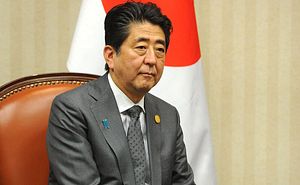On February 10, Japanese Prime Minister Shinzo Abe arrives in Washington, DC. He will be the second foreign leader to visit the White House since the inauguration of President Donald Trump.
During his stay in the United States, the two leaders will not only have an official meeting in the White House, but also will spend the weekend at Trump’s Mar-a-Lago estate in Florida to play a round of golf. Compared to the less-than-desirable outcome of Trump’s recent phone call with Australian Prime Minister Malcolm Turnbull, the leader of a U.S. ally which so far has fought all modern wars alongside the United States, Abe is getting the red-carpet treatment from Trump’s White House.
It probably helps that this will not be the first time for the two leaders to meet. In fact, Abe was one of the first foreign leaders to congratulate Trump for his victory the day after the elections in 2016. Less than two weeks later, Abe visited then President-elect Trump in Trump Tower on November 18, 2016. The meeting lasted closed to 90 minutes, suggesting that the two leaders’ first encounter was very positive.
Abe will have a tough balance to strike in the upcoming visit. On the one hand, he wants to utilize this meeting to further develop a positive personal rapport with Trump. Being a leader who is private and listens to a small number of advisors himself, Abe instinctively understands that it is imperative to gain Trump’s confidence in order to engage in meaningful conversation on any issue.
Indeed, Abe will have a lot to talk about with Trump when the two meet. With Secretary of Defense Jim Mattis having visited Tokyo and reassured Japan of the U.S. defense commitment (he even praised the U.S.-Japan alliance as a “role model of burden-sharing”), the fear within Japanese government about the Trump administration taking a “pay up” approach to push for further increase in host-nation support (HNS), or Trump striking a deal with China on trade and economic issues in exchange for turning away from the U.S. defense commitment in case of clashes over the Senkaku Islands has been greatly alleviated.
However, on the other hand, it is clear that Trump continues to see Japan through the lens of “unfair” trading practices, including currency manipulation Furthermore, Trump pulled the United States out of the Trans-Pacific Partnership (TPP), the multilateral trade deal which Abe pushed through the Japanese Diet by insisting that Japan ought to be alongside the United States in shaping the rules for trade and commerce in the Asia-Pacific region. Abe will have to communicate to Trump that his view of the U.S.-Japan economic relationship is at best outdated and sometimes unambiguously mistaken.
It is important that Abe has a direct line of communication when he tries to talk through these issues. For that, building a personal relationship with Trump himself is of paramount importance. Spending private time with him on the golf course will be definitely helpful to that end.
At the same time, Abe also needs to be aware of the potential backlash of appearing to be friendly with the U.S. president, who has triggered worldwide protest with his executive order that temporarily suspends admittance of Syrian refugees and visitors from seven predominantly Muslim countries. One does not have to go far to look for the backlash. Last month, British Prime Minister Theresa May was harshly criticized within the U.K. for remaining silent on the controversial executive order during her visit to Washington, instead looking touting the “special relationship” between the United States and Britain and inviting Trump for a state visit later in 2017.
Some in Japan already question the wisdom of Abe “promising” to create as many as 700,000 high-quality jobs in the United States through the economic package that is reportedly in the works to be unveiled after their meeting. Like May, Abe will likely face criticism at home if he seems too focused on cultivating a relationship with Trump and appears too open to making compromises on some of the economic issues that the Trump administration is pushing (i.e., a U.S.-Japan Free-Trade Agreement).
Usually, meetings between a Japanese prime minister and U.S. president are measured by whether Japan’s leader is successful in building a close personal relationship with his counterpart. In the upcoming summit, Abe will face a new criteria for success — building a relationship that is close enough to win Trump’s confidence but doing so without looking too eager to please. In that sense, this may be one of the most difficult bilateral summits for Abe.
































